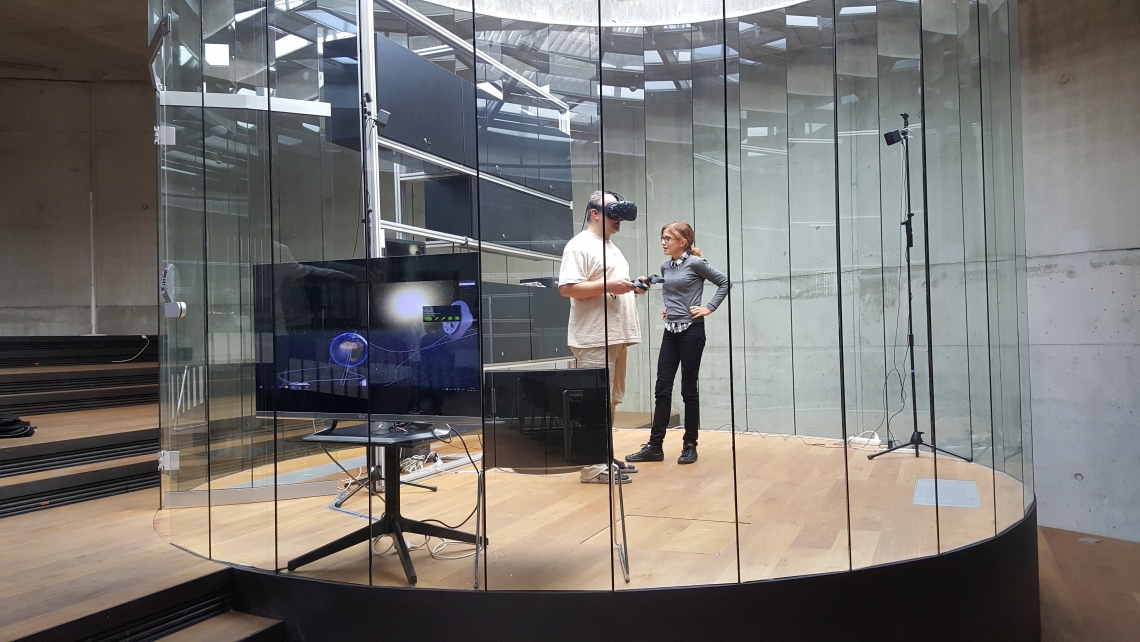Virtual Noordung
HTC Vive Virtual Noordung
The Vitanje-based Cultural and Economic Centre of European Space Technologies (KSEVT) has been focusing on promoting collaboration of Slovenian companies in ESA (European Space Agency) programmes along with other international organisations focusing on the development of space technologies and programmes. The 505VR section of the company Izstop d.o.o. was among a number of Slovenian companies who were invited to participate.
Case
Just like Herman Potočnik Noordung was considered a pioneer in space technologies, we can easily say that today, everyone entering the world of virtual reality is a pioneer.
With the help of virtual reality (VR) we can provide the visitors of KSEVT with a unique display and chance to experience the work of the great Herman Potočnik Noordung. The visitors will be able to »get transferred« to our solar system and take a tour of the Noordung's space station, learning more about the work and life of Herman Potočnik Noordung.
In line with their mission, the client, i.e. KSEVT, has been following the latest trends and achievements in the field of new technologies. They are already experienced in VR technologies, as they have a VR flight simulator at their premises. Since the project with the flight simulation proved to be a success, they decided to try new projects based on VR technologies. 505VR responded to their request for tender and was selected as the best bidder.
With the help of virtual reality (VR) we can provide the visitors of KSEVT with a unique display and chance to experience the work of the great Herman Potočnik Noordung. The visitors will be able to »get transferred« to our solar system and take a tour of the Noordung's space station, learning more about the work and life of Herman Potočnik Noordung.
In line with their mission, the client, i.e. KSEVT, has been following the latest trends and achievements in the field of new technologies. They are already experienced in VR technologies, as they have a VR flight simulator at their premises. Since the project with the flight simulation proved to be a success, they decided to try new projects based on VR technologies. 505VR responded to their request for tender and was selected as the best bidder.
Solution
In view of the customer's requirements we decided the best thing would be to develop a VR presentation used on HTC VIVE system, thus enabling the user to move freely across the room and enjoy high quality image and interaction with the models used. Thus, we developed a 3D model of our solar system along with 3D models of the space station designed by Herman Potočnik Noordung. Making the 3D models was a special challenge, as our only source were the designs by Herman Potočnik Noordung introduced in the book The Problem of Space Travel. Hence, we created a VR presentation on HTC VIVE system, which allows an individual to »walk« among planets which are equipped with info-points providing basic information on each planet. In addition, the user can have an up-close view of a 3D model of a space wheel, a solar powerplant, and an observatory, as imagined by Herman Potočnik Noordung himself. By means of VR technology we were able to show where Noordung's space station was to be located and illustrated its movement in space. Each model
is furnished with basic information, so the users know what exactly they are watching.
Experience
We had a very short time for the execution (i.e. 3 weeks). Considering the time pressure, it was essential that we directed all our resources into this project. The project itself presented a huge challenge to us in the beginning, though we never really imagined its width. An interesting observation is that we have grown together through the project, as we always managed to find
solutions through problems and came up with a superior product. And through it, we discovered the greatness of Herman Potočnik Noordung. Thus, we decided to upgrade and improve the project by
introducing a narrator who takes the visitors of »Virtual Noordung« through the presentation, providing further information on the work of Herman Potočnik Noordung as well as more information on our planets. The narrator is like a guide through the VR presentation, providing suggestions to the visitors as to what they can do in each room. The texts which we added to the presentation were recorded in a recording studio we hired for the job.
Project details
The scope of the project was to develop an application for HTC VIVE, which will represent our solar/planetary system and at the same time enable a 3D view of Noordung's space station designs. The idea is to first introduce Noordung's space station in 3D form, allowing the user to interact with the invention and the solar system (360-degree view, moving between planets, zoom in and zoom out, model rotation, etc.). Fort the purpose of this application we have built a 3D model of our solar system with photorealistic textures, so that the user truly feels like he or she was actually in outer space.
